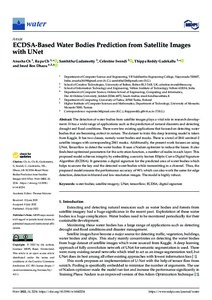ECDSA-Based Water Bodies Prediction from Satellite Images with UNet
Ch Rupa; Iwendi Celestine; Gadekallu Thippa Reddy; Ch Anusha; Gadamsetty Samhitha; Ben Dhaou Imed
ECDSA-Based Water Bodies Prediction from Satellite Images with UNet
Ch Rupa
Iwendi Celestine
Gadekallu Thippa Reddy
Ch Anusha
Gadamsetty Samhitha
Ben Dhaou Imed
MDPI
Julkaisun pysyvä osoite on:
https://urn.fi/URN:NBN:fi-fe2022091258828
https://urn.fi/URN:NBN:fi-fe2022091258828
Tiivistelmä
The detection of water bodies from satellite images plays a vital role in research development. It has a wide range of applications such as the prediction of natural disasters and detecting drought and flood conditions. There were few existing applications that focused on detecting water bodies that are becoming extinct in nature. The dataset to train this deep learning model is taken from Kaggle. It has two classes, namely water bodies and masks. There is a total of 2841 sentinel-2 satellite images with corresponding 2841 masks. Additionally, the present work focuses on using UNet, Tensorflow to detect the water bodies. It uses a Nadam optimizer to reduce the losses. It also finds best-optimized parameters for the activation function, a number of nodes in each layer. This proposed model achieves integrity by embedding a security feature Elliptic Curve Digital Signature Algorithm (ECDSA). It generates a digital signature for the predicted area of water bodies which helps to secure the key and the detected water bodies while transmitting in a channel. Thus, the proposed model ensures the performance accuracy of 94% which can also work the same for edge detection, detection in blurred and low-resolution images. The model is highly robust.
Kokoelmat
- Rinnakkaistallenteet [19207]
